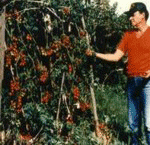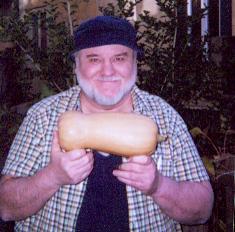 | ||
|
| ||

2000 Cherry Tomatoes From A Single Plant!Watch this free 15 minute video to learn about biodynamics and see the spectacular results for yourself. Follow the directions to grow your own 12 ft. high cherry tomato plant.Click Here | ||
|
| ||
|
We are still at the very beginning of a science investigating life itself that takes processes, chemical transformations, into account and not only the substances themselves. We are seldom aware of the subtle interrelationships of life, for they are hidden within the facts that jump out at you. For example, we all know the buffalo provided meat, hides and bones for the American Indians. And yet, these gifts are almost a side effect, compared to its critical role of building up the deep richness of humus in the prairies. This richness in fertility created the breadbasket of our nation, upon which conventional agriculture still relies and depletes more every year. When we think of the honeybee, we think of her gifts of pollination (about three-fourths of our daily food), of the honey she prepares out of the nectar of plants, of pollen and propolis as healthy dietary supplements. These, too, are minor contributions to life on earth, compared to the far greater importance she holds as sustainer of life with all the stinging insects, hornets, wasps, other bee species, and ants. Sustainer of life?? Isn't this a bit exaggerated?, you might ask. It may seem so, but the facts verify this statement. Let me explain. If we ask which group of organic substances are at the basis of all life processes in plant, animal and the human being, the answer might astonish and surprise you. It's the acids! Little do we consider acids the basis of our physical life, since our perception of them is that they are caustic, corrosive, even dangerous. This they are, but we find them in homeopathic dilution in all life processes in nature and in every part of our body: DNA, fatty acids, amino acids, peptic acid, uric acid, folic acid, just to name the more familiar ones. Without these acids, no life processes could take place. In plants it is the oxalic acid that provides the basic life-giving substance. Oxalis clover, rhubarb, and wood sorrel have lots of oxalic acid, and there we can taste the sour acid element more easily than in most vegetables. In the animal kingdom, specifically in the stinging insects, it is the formic acid that plays a major role. Formic acid (formica=ant) is the poison we feel when an ant bites us, or a wasp or bee stings us. Each of these species produces a variation of formic acid. As the bees and wasps receive nectar and pollen from the flowers, they are able to take in some of this oxalic acid, but they do not only take, they also give to the plants. As these insects fly and crawl through nature, they distribute formic acid. An old forest ranger in Germany once told me that wherever ants are missing in forests, the plants lose their vitality and die more quickly than if there is an ample amount of these insects around. Thus, ant colonies are being reestablished and protected in European forests to keep the trees healthy. This formic acid, in finest dilution, wafts through the air, and in Spring the germinating seeds and budding perennials receive this formic acid that has been produced the year before. These insects not only produce the poison in order to sting, but it is exuded constantly and given off to the atmosphere in the finest dilutions where it remains, ready to serve as the plants spring tonic. So, on such a basic level, these stinging insects are the nurturers of life on earth since they provide something so essential to plants, which, in turn provide food, directly or indirectly, to all other beings. Each one of these two acids acts as an invigorator, as a boost to the life processes for the other kingdom. It is with the help of these minute quantities of formic acid that the earth's entire plant life grows and thrives. And, on the other hand, it is the plants oxalic acid that stimulates and invigorates the animal and human kingdoms. The commonly accepted image we have of life being based on fight and competition, with the survival of the fittest, loses its sting when we consider these grand, symbiotic, mutually beneficial, interrelationships. Let us take a closer look at the role these acids play in our very own lives. As we eat our spinach, broccoli, chard, carrots, fruit and berries, we also take up the oxalic acid contained in them. Now a mysterious transformation occurs; we are able to change this acid into our very own formic acid. Actually, one can achieve this very process in the chemical laboratory. Glycerin is added to oxalic acid in a retort; when heated, carbon dioxide escapes and the steamy vapors condense to and behold formic acid. Similarly, we have small amounts of glycerin in our body and the fire of our digestion is able to instigate this transformation in us. Just as our entire endocrine processes those governing growth, health and reproduction function by virtue of miniscule amounts of the secretion created by the pituitary gland, these same miniscule amounts of formic and oxalic acid provide the basis for life processes in our body. Let us be reminded that without deoxyribonucleic acid (DNA), no life on Earth would be possible. It is this process of transforming oxalic acid into formic acid that allows us to live as spiritual beings in a physical body (as described in Rudolf Steiner's lectures, Bees). We are still at the very beginning of a science investigating life itself that takes processes, chemical transformations, into account and not only the substances themselves. For our life on Earth we depend on the vast numbers of individual stinging insects, which enliven the plant kingdom with their formic acid. Our attitude toward these insects will have to undergo a drastic revision, away from disdain, anger, and fear toward one of gratitude and respect, toward nurturing and partnership instead of killing or exploitation. We can now understand that our lives depend on honeybees, ants, wasps, and hornets. But why does the honeybee take a special place among all these formic acid-producing insects? In contrast to the solitary and bumble, carpenter and orchard bees, or hornets and wasps, the honeybees live through the winter as a colony of 10,000-20,000 individual workers. By the end of March, they may have already doubled their numbers and by summer solstice may reach 40,000-60,000 in number. Bumble and orchard bees, wasps and hornets have only young queens surviving the winter, and it takes two to three months until a colony of several hundred insects can do their enlivening work in nature. The vast numbers of honeybees flying already in early Spring not only contribute to the much needed pollination, but to the amount of formic acid released into nature. We may now better appreciate the statement that our very lives depend on the care of the honeybee, on beekeeping. To those who are aware of this fact, Colony Collapse Disorder (not only a national, but rather a global phenomenon) becomes a crisis as serious as global warming. In the United States alone we have lost millions of colonies in the last two decades. Do farmers, gardeners, and forest rangers witness the decline in natural vitality in their crops? You bet! Not only are our elm trees practically gone, now it's our ash trees, coastal oaks, beeches and other species that are being diminished in great numbers. We try to blame this decline on beetles, viruses or air pollution. These may be a contributing factor, but on a much deeper level it is the diminishing multitudes of stinging insects many of these are simply diminished by the monocultures that result in lack of forage, as well as by all the poisons and pollution put into our environment that pose a real threat to life on earth. In 2006 (before Colony Collapse Disorder was identified), Spikenard Farm was founded with the vision to establish a biodynamic farm with a honeybee sanctuary at its heart. It is located on 610 beautiful acres in the country's heartland Illinois. While still in its beginning, a lot has been accomplished and the honeybees at Spikenard survived the winter with only 7 percent losses (one colony due to mouse damage). Annual and perennial forage is being planted and organic, sustainable beekeeping methods are being taught methods that are, to a large extent, diametrically opposed to conventional beekeeping practices which, combined with our poison-laden agriculture, are at the root of the CCD phenomenon. In 1923, in his lectures on bees and other insects, Rudolf Steiner said that if we did not change the industrialized beekeeping methods (which had been introduced two to three decades before), the honeybee might not survive the 20th century. This statement was not accepted by Mr. Mueller, a beekeeper attending the lectures. Steiner simply said that the long-term effect of these methods could not be seen right away and offered Mr. Mueller a conversation in 80 years. If they had talked in 2003, what would Mr. Mueller say now? Gunther Hauk is the president of the Spikenard Farm Board. You can visit Spikenard's website, www.spikenardfarm.org, to learn more about the farm and how you can support our efforts to provide a place of nurture and healing for the honeybee.
|
|
|
| ||
|
| |||
HOME
Copyright 2007 L.A. Rotheraine
 Honeybees and the Symbiotic Significance of Formic and Oxalic Acid
Honeybees and the Symbiotic Significance of Formic and Oxalic Acid



